Allegiance United Kingdom India Rank Squadron leader Education University of Mumbai | Name Mohinder Pujji Years of service 1940–1947 | |
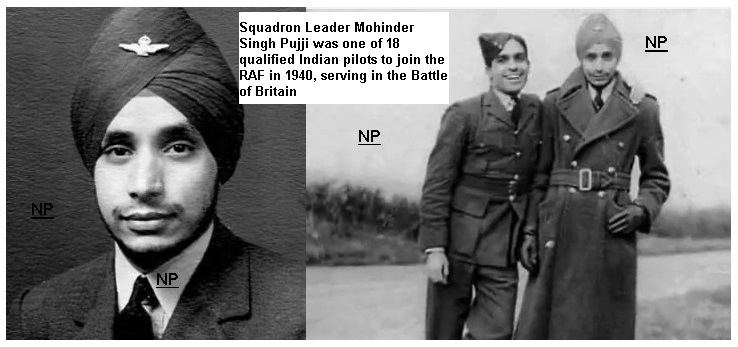 | ||
Awards DFC1939–45 StarAir Crew Europe StarAfrica StarBurma StarDefence MedalWar Medal 1939–1945Honorary Freeman of the Borough of Newham Other work Airline pilot, aerodrome officer Battles and wars World War II, Battle of Britain | ||
Mohinder singh pujji dfc statue
Squadron Leader Mohinder Singh Pujji DFC (14 August 1918 – 18 September 2010), also known as Mahinder Singh Pujji, was a distinguished Royal Air Force fighter pilot and one of the first Indian Sikh pilots to volunteer with the Royal Air Force during the Second World War.
Contents
- Mohinder singh pujji dfc statue
- Mahinder Singh Pujji DFC
- Early life
- War service
- Post war
- Recognition
- References
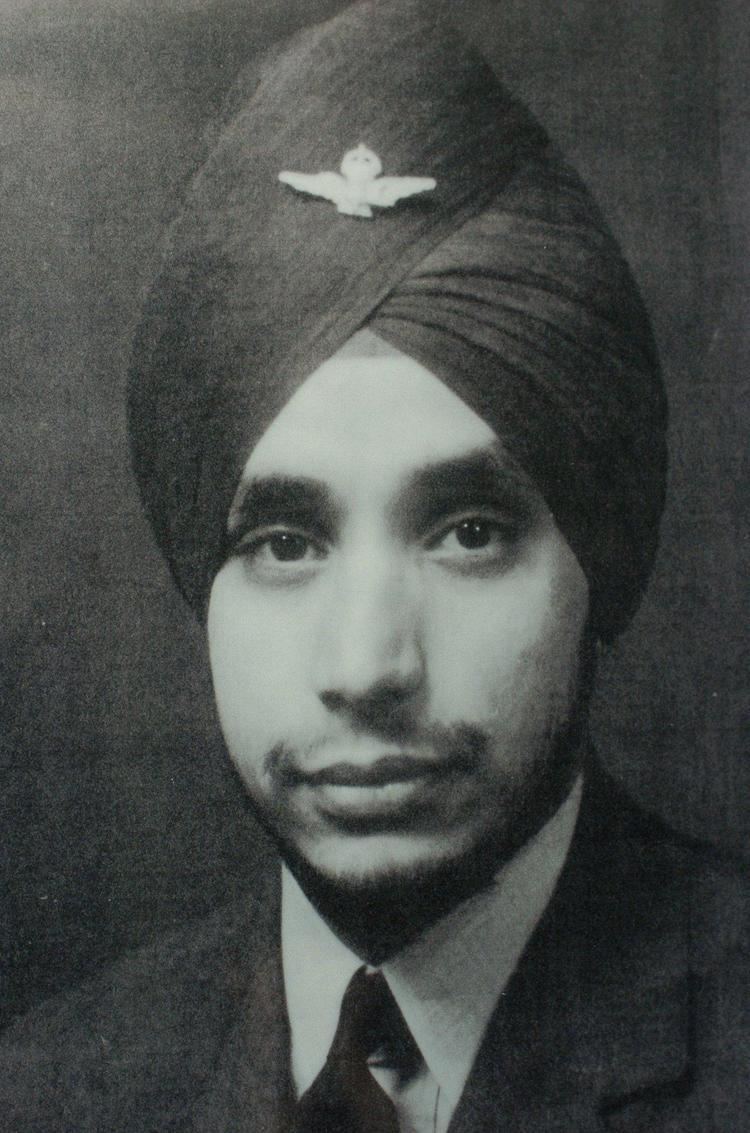
Mahinder Singh Pujji DFC
Early life
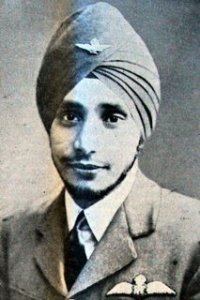
Mohinder Singh Pujji was born in Simla, British Punjab, on 14 August 1918, the fourth son of Sardar Sohan Singh Pujji and his wife, Sant Kaur. His father was a senior government official who worked in the Department of Health and Education. He attended the Sir Harcourt Butler High School in Simla, then on his father's retirement to his home state of Punjab attended the Government College and later the Hindu College in Lahore.
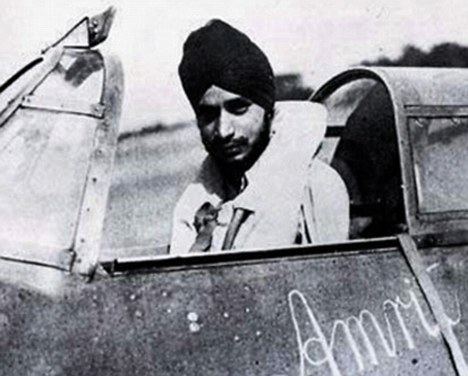
He learned to fly in 1936 as a hobby pilot at the Delhi Flying Club, where he fell in love with flying and in April 1937 received his Indian commercial 'A' pilot's licence. His first job was as a pilot with Himalayan Airways, flying passengers between Haridwar and Badrinath, but soon after was offered a better job with Burmah Shell as a refueling superintendent in 1938.
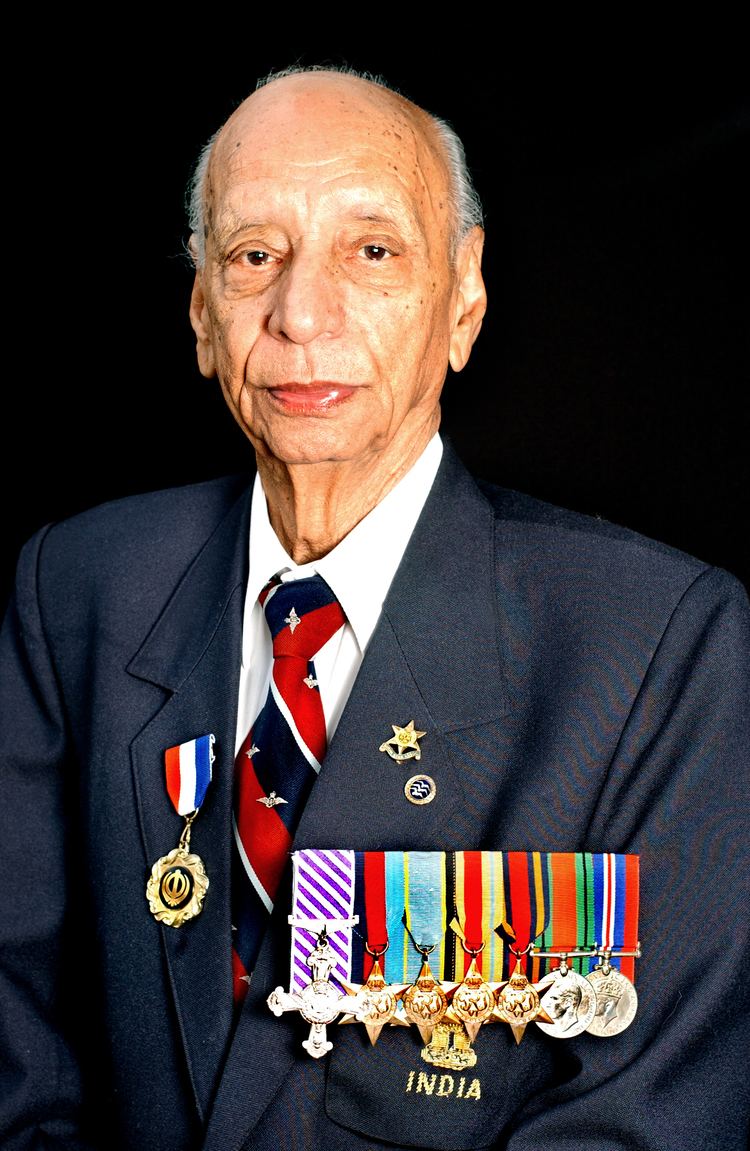
He married Amrit Kaur in November 1944. Their first daughter, Veena was born in March 1946. The couple had two more children, Rita and Satinder. These three Sikh children grew up and married spouses from three different religions, showing one of the earliest acts of a truly global family. Veena, a sardarni, married Hindu businessman, Prem Gupta, owner of The International Angora Breeding Farm. Rita, also a sardarni, married a Muslim man, Mobez Arsiwala, working in the aviation industry. Satiner, a sardar, married his catholic British girl-friend, Maggie Little.
War service
In 1940, he attended the Indian Air Force 4th Pilots Course, and became one of the first batch of 24 Indian 'A' licence holder pilots accepted to receive a Volunteer Reserve commission with the Royal Air Force during the early part of the Second World War, despite his parents' fears.
Embarking for the United Kingdom, his first posting was on 8 October 1940 to No. 1 RAF Depot in Uxbridge. Within a few days he was posted to No. 12 Elementary Flying Training School RAF at Prestwick in Scotland. From there the first 24 volunteer Indian pilots went on to No. 9 (Pilot) Advanced Flying Unit RAF at RAF Hullavington. They completed the course, and received their RAF wings on 16 April 1941. A few weeks later he and a handful of other pilots from the first 24 went on to the renowned No. 56 Operational Training Unit (OTU) at RAF Sutton Bridge, where they joined British and other foreign-allied pilots for advanced fighter pilot training on the Hawker Hurricane.
He flew active service with No. 43 Squadron RAF, the formidable 'Fighting Cocks' fighter squadron. He flew Hurricanes, which he preferred to Spitfires, for their relative ease of flying. He was forced down twice; in one instance, his aircraft was disabled over the English Channel by a Messerschmitt, but he managed to coax it to dry land, where he crashed. He was rescued from the burning wreckage and after a week in hospital, Mohinder Singh returned to duty.
He was treated well in England, getting preferential treatment at local cinemas and restaurants, often without payment. He subsequently commented, "I felt very welcome indeed, I never felt different or an outsider and my experiences in this country made me keen to return some time after the war. I was made to feel very much at home by everyone I met" and "I wrote back to my father saying that I did not mind if I was killed because the British people were wonderful and so brave, and I was being so well treated. I could not queue for a movie without being told to move to the front." As a Sikh, he insisted on retaining his dastar (Sikh headdress), with RAF insignia, even while flying, even carrying a spare, in case it was needed. The dastar interfered with use of his oxygen mask and resulted in damage to his lungs. (Subsequently, in 1960, he gave up wearing the dastar.)
After the Battle of Britain, Mohinder Singh was sent to the Middle East where, in 1941, he was forced down, for the second time, in the North African desert and was picked up by British troops. He had dietary problems, as he could not eat the standard issue bully beef for religious reasons. He returned to south Asia and served in Afghanistan and Burma, where he was awarded the DFC. Announced in The London Gazette on 17 April 1945, and followed with a personal letter of congratulations from Air Chief Marshal Sir Keith Park, the DFC citation reads in part:
Acting Flight Lieutenant Mahinder Singh Pujji No. 4 (RIAF) Squadron
"This officer has flown on many reconnaissance sorties over Japanese occupied territory, often in adverse monsoon weather. He has obtained much valuable information on enemy troop movements and dispositions, which enabled an air offensive to be maintained against the Japanese troops throughout the monsoon. Flight Lieutenant Pujji has shown himself to be a skilful and determined pilot who has always displayed outstanding leadership and courage."Post-war
In late 1946, after suffering from a long illness of tuberculosis, which nearly cost him his life; caused him to become classified unfit for military service and receive a permanent disability discharge from the Royal Indian Air Force. From 1947, Mohinder Singh was employed as an Aerodrome Officer at Safdarjung Aerodrome Delhi, where he also continued to fly in a civilian role. He went on to aspire as a champion air race pilot and holder of gliding records.
Mohinder Singh moved to East Ham, England, after retirement and he became an active member of the local community. Later, he settled in Gravesend, Kent. On 12 October 2000, he was made an Honorary Freeman of the Borough of Newham.
In 2005, Mohinder Singh protested against the British National Party's use of an image of a Spitfire in their campaign literature. He was reported as saying,
"The BNP are wrong to use the Spitfire as representative of their party. They forget people from different backgrounds helped in the Second World War. I am proof of this - I was flying a Spitfire. I also met Winston Churchill. Even in those days, there were ethnic minorities fighting for the British. I would recommend the armed forces for young people, regardless of race."
In August 2010, his autobiography For King And Another Country was released.
Mohinder Singh Pujji died of a stroke at Darent Valley Hospital on 18 September 2010, aged 92. He is survived by two daughters, one son, seven grandchildren and five great-grandchildren. The local authority Gravesham Borough Council, celebrated his life and heroism with an exhibition.
In 2011 the short film The Volunteers was dedicated to Mohinder after he contributed to the making, but died before the films completion.
Recognition
Despite the high respect that he experienced during the war, Mohinder Singh believed that war films presented a "white-only view of the RAF". He campaigned to have the Sikh contribution to the British war effort, which he believed had been ignored, more widely recognised. He was never invited to any of the many events in Britain that marked the 70th anniversary of the outbreak of World War II in 2010, or any other year, he says. He is quoted as saying, "As far as I think, no one in authority remembers that we are here and we were a part of World War II".
In an effort to redress the balance, the Royal Air Force Museum Cosford opened a permanent exhibition in January 2009 ("Diversity in the Royal Air Force"), intended to "challenge negative perceptions, by celebrating the racial diversity of its history". Mohinder Singh was the guest of honour at the opening.
A statue of Sqn Ldr Pujji by Douglas Jennings was unveiled in St Andrew's Gardens, Gravesend on 28 November 2014. It bears the inscription: "To commemorate those from around the world who served alongside Britain in all conflicts 1914-2014".
